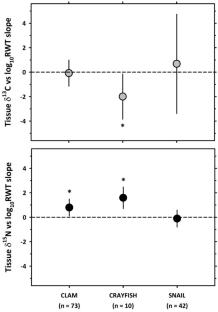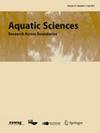Ontogenetic variation in isotopic niche positions of aquatic consumers in boreal lakes
Abstract
We used an extensive multispecies dataset to examine how C and N stable isotope ratios (δ13C and δ15N) of aquatic consumers varied with body size in populations of northern lakes. Ontogenetic variation in tissue δ13C and δ15N was evident in a diversity of aquatic consumers. Relationships with body size tended to be stronger and more consistently positive for δ15N, and more variable in nature for δ13C. Among-population variation in ontogenetic slopes was greater for δ13C than for δ15N for most biota examined. Relationships between δ13C and δ15N and body size were still significant even after accounting for variation owing to tissue C:N and body condition. Ontogenetic variation was more strongly linked to age than body size in some fishes, particularly for δ15N, but age effects, inferred from growth rate, also accounted for variation in δ13C and δ15N beyond body size effects; δ13C tended to be positively related and δ15N tended to be negatively related to growth rate. There was only limited evidence of concordance in ontogenetic slopes between co-habiting pairs of species, suggesting that the factors driving ontogenetic variation in stable isotope ratios may be largely species- or population-specific. However, ontogenetic slopes of individual taxa were related to various lake habitat features representing climate, ecosystem size, and water clarity. The proportion of isotopic niche space attributable to ontogenetic variation can be substantial and this has implications for applying and interpreting isotopic niche metrics. Our study provides the broadest and most comprehensive analysis of ontogenetic variation in isotopic compositions of freshwater consumers to date and our results underscore the need to account for this variation in the analysis of freshwater food webs.



 求助内容:
求助内容: 应助结果提醒方式:
应助结果提醒方式:


